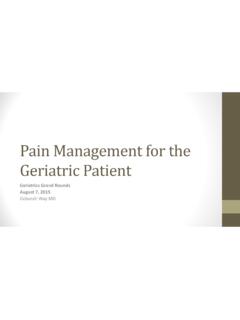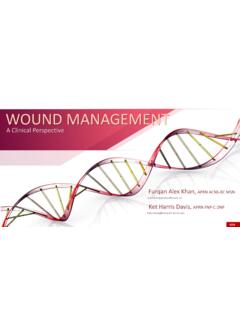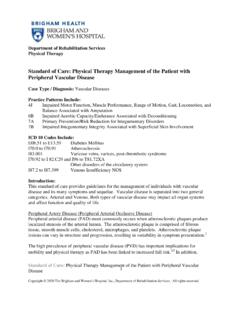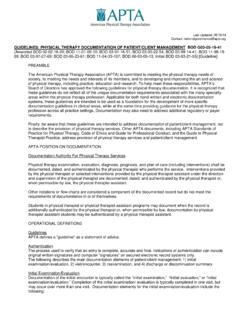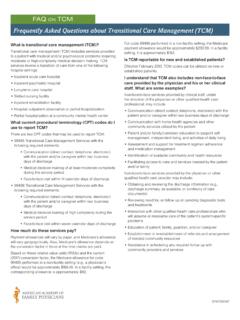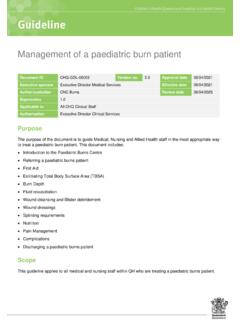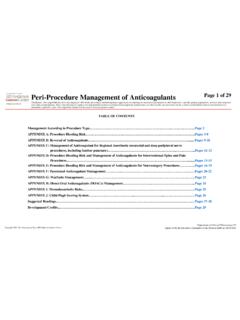Transcription of Surgical Wound Dehiscence - Identification and Management
1 Surgical Wound Dehiscence - Identification and ManagementProf Karen OuseyInstitute of Skin Integrity and Infection PreventionUniversity of What does SWD mean to you? Wound disruption Wound separation Wound opening Wound rupture Wound breakdown Wound failure Surgical site failure Post-operative Wound Dehiscence Burst abdomen Fascial dehiscenceWhat does SWD mean to you? Reserved exclusively for the serious event of evisceration of abdominal contents that may occur following failure of a large abdominal Surgical incision. To others, meaning covers a spectrum of problems ranging from: superficial separation of part of an incision complete separation of the full depth of the incision with exposure of body organs or Surgical implantsDefinition Surgical Wound Dehiscence (SWD) is the separation of the margins of a closed Surgical incision that has been made in skin, with or without exposure or protrusion of underlying tissue, organs or implants.
2 Separation may occur at single or multiple regions, or involve the full length of the incision, and may affect some or all tissue layers. A dehisced incision may, or may not, display clinical signs and symptoms of causes SWD? Technical issues with the closure of the incision unravelling of suture knots Mechanical stress coughing can cause breakage of the sutures or rupture of the healing incision after suture or clip removal/reabsorption Disrupted healing due to comorbidities or treatments that hamper healing, or as a result of a Surgical site infection (SSI)Causes of SWD Major risk factors for SWD are: Obesity (body mass index (BMI) 35kg/m2) Diabetes mellitus Current or recent smoking Emergency surgery Age >65 years Extended duration of surgery Inadequate Surgical closure Peri-operative hypothermia and Wound infectionRisk factors for SWD Sandy-Hodgetts, et al.
3 (2018) Surgical Wound Dehiscence : a conceptual framework for patient assessment. Journal of Wound Care 27(3) do we assess SWD? Prior to assessment of SWD, the events, leading to the Dehiscence , coughing, vomiting, trauma, suture/clip removal, purulent drainage, should be ascertained. SWD occurring very soon after surgery and of very recent occurrence may be suitable for re-suturing. The entire length of an incision with SWD should be fully assessed: the factors that led to the SWD may also be affecting other regions of the incision that remain closedHow do we classify SWD? Classification allows for a systematic and reproducible method for identifying, measuring and recording an event ( pressure injury, skin tear)Distinct absence of grading system for SWD describing Wound characteristics to inform evidence based practice clinical Management of SWD.
4 The Sandy SWD Grading System came about from the doctoral research of Kylie Sandy-Hodgetts in 2017. This grading system was adapted by the WUWHS SWD Consensus Document: prevention and outcomes. Sandy-Hodgetts, K. (2017) Clinical innovation: The Sandy Grading System for Surgical Wound Dehiscence Classification a new taxonomy. Wounds InternationalVol 8 Issue 4 Assessment Medical and Surgical history Nature of the Surgical procedure ( elective/emergency, closing method, type of surgery) Current health Lifestyle Current medication Pain Psychosocial status care setting, occupation, concordance, QoLIncision/ Wound assessment Prior to assessment of SWD, the events, leading to the Dehiscence , coughing, vomiting, trauma, suture/clip removal, purulent drainage, should be ascertained.
5 SWD occurring very soon after surgery and of very recent occurrence may be suitable for re-suturing. The entire length of an incision with SWD should be fully assessed: the factors that led to the SWD may also be affecting other regions of the incision that remain closedRemember If more than one area of Dehiscence is present, each area should be assessed individually A short area of Dehiscence is not necessarily only superficial and may extend deeply Probing should be undertaken very gently and carefully to avoid inadvertently exacerbating the Dehiscence or causing other damage All general and Wound assessments, further tests, interventions and referrals should be WUWHS SWD Grading SystemWUWHS SWD Grade*DescriptorsIncreasing severitySingle/multiple regions or full-length separation of the margins of a closed Surgical incision.
6 Occurring up to 30 days after the procedure 1 Dermal layer only involved; no visible subcutaneous fat No clinical signs and symptoms of infection1aAs Grade 1 plus clinical signs and symptoms of infection ( superficial incisional SSI)2 Subcutaneous layer exposed; fascia not visible No clinical signs and symptoms of infection2aAs Grade 2 plus clinical signs and symptoms infection ( superficial incisional SSI)3 Subcutaneous layers and fascia exposed No clinical signs and symptoms of infection3aAs Grade 3 plus clinical signs and symptoms infection ( deep incisional SSI)4^Any area of fascial Dehiscence with organ space, viscera, implant or bone exposed No clinical signs and symptoms infection4a^As Grade 4 plus clinical signs and symptoms infection ( organ/space SSI)
7 *Grading should take place after full assessment including probing or exploration of the affected area as appropriate by a clinician with suitable competency Where this is >1 region of separation of the Wound margins, SWD should be graded according to the deepest point of separation Where day 1 = the day of the procedure^Grade 4/4a Dehiscence of an abdominal incision may be called burst abdomen WUWHS SWD Classification WUWHS SWD Grade 1 -Small area of dermal separationWUWHS SWD Classification WUWHS SWD Grade 1a Post-mastectomy: small areas of dermal separation with inflammation and infectionWUWHS SWD Classification WUWHS SWD Grade 2 -Obese patient with exposed subcutaneous tissue and tunnel into pannus following surgery for seatbelt traumaWUWHS SWD Classification WUWHS SWD Grade 2a -Post-mammoplasty: dermal separation with exposure of subcutaneous tissue with inflammation and purulent exudateWUWHS SWD Classification WUWHS SWD Grade 3 -Post-spinal surgery: full length Dehiscence with fascial exposure without signs of infectionWUWHS SWD Classification WUWHS SWD Grade 3a -Leg incision: Dehiscence exposing muscle and fascia with pus and cellulitisWUWHS SWD Classification WUWHS SWD Grade 4 -Post-laparotomy.
8 Dehiscence with abdominal organ exposure and no signs of infectionWUWHS SWD Classification WUWHS SWD Grade 4a -Separation of suture line with exposed hardware with inflammation and signs of infectionIs this SWD? Multiple small areas of superficial SWD with signs of infection following mastectomyIs this SWD? SWD after reduction mammoplastySWD? SWD with abscess formation and draining pus following total knee arthroplastySWD? Abdominal Wound Dehiscence post-laparotomy Using TIME to assess SWDI ncisional healing and TIME30 Incisional parameterRelationship to TIME frameworkIncision colourTissueHealing ridgePeri-incisional areaInfection/inflammationExudateMoistur eWound marginsEdgeSigns that incisional healing is progressing well31 Relationship to TIME frameworkSigns of healing progressionTissue incision colour Days 1 4: red Days 5 14: bright pink Day 15 1 year: pale pink, progressing to white or silver or darker than usual skin colourTissue healing ridge Days 5 9.
9 A healing ridge of thickened tissue indicating newly formed collagen can be felt about 1cm either side of the incision along its length, and persists into the remodelling phaseInfection/ inflammation peri-incisional area Signs of inflammation: mild oedema, erythema, warmth or skin discolouration that resolves by day 5 PainMoisture exudate Days 1 4: decreasing volume from moderate to minimal and changing from sanguineous to serosanguineous to serous Resolves by day 5 Edge Wound margins Epithelial closure should be seen by day 4 along the entire incision Edges are approximatedSigns that incisional healing may be impaired32 Relationship to TIME frameworkSigns of healing impairmentTissue incision colour Days 1 4: may be red.
10 Tension in the incision line Days 5 9: edges may be well-approximated and the tension remains Day 10 14 : if SWD does not occur, colour may remain red or progress to pink and may be followed ultimately by hypertrophic scarringTissue healing ridge Lack of healing ridgeInfection/ inflammation peri-incisional area Signs of inflammation may be absent in the first few days after surgery Signs of inflammation and pain may be present for extended periodsMoisture exudate Exudate persists beyond day 1 4 Exudate may be serosanguineous, serous or purulent ( cloudy, green, yellow or brown)Edge Wound margins Epithelial resurfacing may be only partially present or entirely absent Area(s) of separation (SWD) may be present by day 14 Assessment of SWD using the TIME framework33 ParameterAssessSpecificsTissue Location and extent of Dehiscence Location of the incision Proportion of the incision affected Number of areas of Dehiscence Presence of sutures/clips and condition (intact/broken) Depth of Dehiscence Partial or full-thickness Dehiscence and tissue layers affected (WUWHS SWD Grade) Extension to or exposure of organs/bone/implant Presence of undermining/tunnelling For abdominal SWD, presence of evisceration Tissue viability Condition of exposed tissues Wound bed tissue types and proportions of necrotic/devitalised tissue, slough and granulation tissue Dimensions Dimensions of the dehisced area(s).

